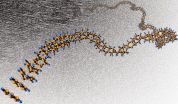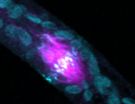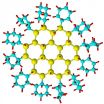(Press-News.org) Cambridge, MA, September 25, 2014 — Researchers from the Broad Institute and Massachusetts Institute of Technology have created a new mouse model to simplify application of the CRISPR-Cas9 system for in vivo genome editing experiments. The researchers successfully used the new "Cas9 mouse" model to edit multiple genes in a variety of cell types, and to model lung adenocarcinoma, one of the most lethal human cancers. The mouse has already been made available to the scientific community and is being used by researchers at more than a dozen institutions. A paper describing this new model and its initial applications in oncology appears this week in Cell.
In recent years, genetic studies have found thousands of links between genes and various diseases. But in order to prove that a specific gene is playing a role in the development of the disease, researchers need a way to perturb it – that is, turn the gene off, turn it on, or otherwise alter it – and study the effects.
The CRISPR-Cas9 genome-editing system is one of the most convenient methods available for making these alterations in the genome. While the tool is already being used to test the effects of mutations in vitro – in cultured cell lines, for instance – it is now possible to use this tool to study gene functions using intact biological systems.
The CRISPR-Cas9 system relies on two key features to edit the genome: Cas9, a "cleaving" enzyme capable of cutting DNA; and guide RNA, a sequence that directs Cas9 to the DNA target of interest in the genome. However, the Cas9 enzyme presents some delivery challenges for in vivo applications.
"By equipping the mouse with Cas9, we relieved the burden of delivery. This frees up space for the delivery of additional elements – whether by viruses or nanoparticles – making it possible to simultaneously mutate multiple genes and even make precise changes in DNA sequences," said Randall Platt, a graduate student at MIT working at the Broad Institute in the lab of Feng Zhang, an assistant professor at the McGovern Institute for Brain Research at MIT, and a core member of the Broad Institute. Platt and Sidi Chen, a postdoctoral fellow at MIT's Koch Institute for Integrative Cancer Research working in the lab of Institute Professor Phillip Sharp, were co-first authors of the paper.
This ability to perturb multiple genes at the same time may be particularly useful in studying complex diseases, such as cancer, where mutations in more than one gene may be driving the disease. To demonstrate a potential application for cancer research, the authors used the "Cas9 mouse" to model lung adenocarcinoma. Previously, scientists working with animal models have had to knock out one gene at a time, or cross animal models to produce one with the needed genetic modifications, processes that are challenging and time consuming.
"The 'Cas9 mouse' allows researchers to more easily perturb multiple genes in vivo," said Zhang, who, along with Sharp, served as co-senior author of the Cell paper. "The goal in developing the mouse was to empower researchers so that they can more rapidly screen through the long list of genes that have been implicated in disease and normal biological processes."
Researchers contributing to the paper also found that cells derived from the "Cas9 mouse" could be extracted for use in lab experiments and were able to leverage the Cas9-expressing cells to edit immune dendritic cells even after the cells had been removed from the mouse, allowing the researchers to experiment with cells that aren't easily accessible and often lack the shelf life to conduct such experiments.
"As we demonstrated with immune cells, the mouse allows us to experiment with cells that only remain viable for a few days ex vivo by leveraging the fact that they already express Cas9. Absent the expression of Cas9, we would not have sufficient time for the CRISPR system to work its magic," said Broad core member and paper co-author Aviv Regev, who is an associate professor of biology at MIT. Regev's lab, along with the lab of Broad senior associate member Nir Hacohen (a faculty member at Massachusetts General Hospital and Harvard Medical School), used the mouse to investigate dendritic cells, as reported in the Cell study.
"Genetic manipulation is one of the most critical tools we have for investigating complex circuits, and the 'Cas9 mouse' will help us do it more effectively," said Regev.
The "Cas9 mouse" has been deposited with Jackson Laboratory, where it is available to the entire scientific community by request.
INFORMATION:
The study was supported by the National Science Foundation; The Damon Runyon Cancer Research Institute; Simons Center for the Social Brain at MIT; the National Institute of Health's National Human Genome Research Institute, National Cancer Institute, and National Institute of Mental Health; Helmsley Charitable Trust; Klarman Cell Observatory; the National Cancer Institute; the Koch Institute for Integrative Cancer Research; the Broad Institute's Stanley Center for Psychiatric Research; Howard Hughes Medical Institute; the Marie D. and Pierre Casimir-Lambert Fund; Bob Metcalfe; and the Keck, Searle Scholars, Klingenstein, Vallee, and Merkin Foundations.
Other researchers who worked on the study include: Yang Zhou, Michael Yim, Lukasz Swiech, Hannah Kempton, James Dahlman, Oren Parnas, Thomas Eisenhaure, Marko Jovanovico, Daniel Graham, Siddharth Jhunjhunwala, Ramnik Xavier, Robert Langer, Daniel Anderson, and Guoping Feng.
Paper cited:
Platt, R. et al. "CRISPR-Cas9 knockin mice for genome editing and cancer modeling." Cell. September 25, 2014. DOI: 10.1016/j.cell.2014.09.014
About the engineered CRISPR-Cas9 system
CRISPRs (Clustered Regularly Interspaced Short Palindromic Repeats) have recently been harnessed as genome editing tools in a wide range of species. The engineered CRISPR-Cas9 system allows researchers to mutate or change the expression of genes in living cells, including those of humans. The family of Cas9 nucleases (also known as Cas5, Csn1, or Csx12) recognizes DNA targets in complex with RNA guides. Researchers can now harness the engineered system to home in on specific nucleic acid sequences and cut the DNA at those precise targets. The cuts modify the activity of the targeted genes, allowing researchers to study the genes' function.
About the Broad Institute of Harvard and MIT
The Eli and Edythe L. Broad Institute of Harvard and MIT was launched in 2004 to empower this generation of creative scientists to transform medicine. The Broad Institute seeks to describe all the molecular components of life and their connections; discover the molecular basis of major human diseases; develop effective new approaches to diagnostics and therapeutics; and disseminate discoveries, tools, methods and data openly to the entire scientific community.
Founded by MIT, Harvard and its affiliated hospitals, and the visionary Los Angeles philanthropists Eli and Edythe L. Broad, the Broad Institute includes faculty, professional staff and students from throughout the MIT and Harvard biomedical research communities and beyond, with collaborations spanning over a hundred private and public institutions in more than 40 countries worldwide. For further information about the Broad Institute, go to http://www.broadinstitute.org.
Researchers engineer 'Cas9' animal models to study disease and inform drug discovery
Cas9 animal model provides powerful, time-saving tool
2014-09-25
ELSE PRESS RELEASES FROM THIS DATE:
Satellite catches an oval-shaped Tropical Storm Rachel
2014-09-25
NOAA's GOES-West satellite spotted the eighteenth tropical depression of the Eastern Pacific grow into a tropical storm that was renamed Rachel today, Sept. 25, 2014. Wind shear is affecting the tropical storm, however, so it doesn't have a rounded appearance on satellite imagery.
Tropical Depression 18-E formed on Wednesday, Sept. 24 around 11 a.m. EDT about 285 miles (460 km) south-southwest of Manzanillo, Mexico. Manzanillo is a city in the Manzanillo municipality of the Mexican state of Colima on the country's west coast.
In an infrared image from NOAA's GOES-West ...
Can genetic engineering help food crops better tolerate drought?
2014-09-25
New Rochelle, NY, September 25, 2014—The staggering growth rate of the global population demands innovative and sustainable solutions to increase food production by as much as 70-100% in the next few decades. In light of environmental changes, more drought-tolerant food crops are essential. The latest technological advances and future directions in regulating genes involved in stress tolerance in crops is presented in a Review article in OMICS: A Journal of Integrative Biology, the peer-reviewed interdisciplinary journal published by Mary Ann Liebert, Inc., publishers. ...
Goats better than chemicals for curbing invasive marsh grass
2014-09-25
DURHAM, N.C. -- Herbivores, not herbicides, may be the most effective way to combat the spread of one of the most invasive plants now threatening East Coast salt marshes, a new Duke University-led study finds.
Phragmites australis, or the common reed, is a rapid colonizer that has overrun many coastal wetlands from New England to the Southeast. A non-native perennial, it can form dense stands of grass up to 10 feet high that block valuable shoreline views of the water, kill off native grasses, and alter marsh function.
Land managers traditionally have used chemical ...
Smallest-possible diamonds form ultra-thin nanothread
2014-09-25
Washington, D.C.— A team including Carnegie's Malcolm Guthrie and George Cody has, for the first time, discovered how to produce ultra-thin "diamond nanothreads" that promise extraordinary properties, including strength and stiffness greater than that of today's strongest nanotubes and polymer fibers. Such exceedingly strong, stiff, and light materials have an array of potential applications, everything from more-fuel efficient vehicles or even the science fictional-sounding proposal for a "space elevator." Their work is published in Nature Materials.
The team—led by ...
Genes causing pediatric glaucoma contribute to future stroke
2014-09-25
(Edmonton, AB) Every year in Canada about 50,000 people suffer from a stroke, caused either by the interruption of blood flow or uncontrolled bleeding in the brain. While many environmental risk factors exist, including high blood pressure and smoking, stroke risk is also frequently inherited. Unfortunately, remarkably little is known regarding stroke's genetic basis.
A study from the University of Alberta, published in the Journal of Clinical Investigation, extends knowledge of stroke's genetic underpinnings and demonstrates that in some cases it originates in infancy.
The ...
Unlocking long-hidden mechanisms of plant cell division
2014-09-25
AMHERST, Mass. – Along with copying and splitting DNA during division, cells must have a way to break safely into two viable daughter cells, a process called cytokinesis. But the molecular basis of how plant cells accomplish this without mistakes has been unclear for many years.
In a new paper by cell biologist Magdalena Bezanilla of the University of Massachusetts Amherst, she and her doctoral student Shu-Zon Wu present a detailed new model that for the first time proposes how plant cells precisely position a "dynamic and complex" structure called a phragmoplast at the ...
Risk of esophageal cancer decreases with height
2014-09-25
Bethesda, MD (Sept. 25, 2014) — Taller individuals are less likely to develop esophageal cancer and it's precursor, Barrett's esophagus, according to a new study1 in Clinical Gastroenterology and Hepatology, the official clinical practice journal of the American Gastroenterological Association.
"Individuals in the lowest quartile of height (under 5'7" for men and 5'2" for women) were roughly twice as likely as individuals in the highest quartile of height (taller than 6' for men and 5'5" for women) to have Barrett's esophagus or esophageal cancer," said Aaron P. Thrift, ...
Putting the squeeze on quantum information
2014-09-25
CIFAR researchers have shown that information stored in quantum bits can be exponentially compressed without losing information. The achievement is an important proof of principle, and could be useful for efficient quantum communications and information storage.
Compression is vital for modern digital communication. It helps movies to stream quickly over the Internet, music to fit into digital players, and millions of telephone calls to bounce off of satellites and through fibre optic cables.
But it has not been clear if information stored in quantum bits, or qubits, ...
Looking for a spouse or a companion
2014-09-25
New Rochelle, NY, September 25, 2014—The increasing popularity of social media, online dating sites, and mobile applications for meeting people and initiating relationships has made online dating an effective means of finding a future spouse. The intriguing results of a new study that extends this comparison of online/offline meeting venues to include non-marital relationships, and explores whether break-up rates for both marital and non-marital relationships differ depending on whether a couple first met online or offline are reported in an article in Cyberpsychology, ...
World's smallest reference material is big plus for nanotechnology
2014-09-25
If it's true that good things come in small packages, then the National Institute of Standards and Technology (NIST) can now make anyone working with nanoparticles very happy. NIST recently issued Reference Material (RM) 8027, the smallest known reference material ever created for validating measurements of these man-made, ultrafine particles between 1 and 100 nanometers (billionths of a meter) in size.
RM 8027 consists of five hermetically sealed ampoules containing one milliliter of silicon nanoparticles—all certified to be close to 2 nanometers in diameter—suspended ...
LAST 30 PRESS RELEASES:
Numbers in our sights affect how we perceive space
SIMJ announces global collaborative book project in commemoration of its 75th anniversary
Air pollution exposure and birth weight
Obstructive sleep apnea risk and mental health conditions among older adults
How talking slows eye movements behind the wheel
The Ceramic Society of Japan’s Oxoate Ceramics Research Association launches new international book project
Heart-brain connection: international study reveals the role of the vagus nerve in keeping the heart young
Researchers identify Rb1 as a predictive biomarker for a new therapeutic strategy in some breast cancers
Survey reveals ethical gaps slowing AI adoption in pediatric surgery
Stimulant ADHD medications work differently than thought
AI overestimates how smart people are, according to HSE economists
HSE researchers create genome-wide map of quadruplexes
Scientists boost cell "powerhouses" to burn more calories
Automatic label checking: The missing step in making reliable medical AI
Low daily alcohol intake linked to 50% heightened mouth cancer risk in India
American Meteorological Society announces Rick Spinrad as 2026 President-Elect
Biomass-based carbon capture spotlighted in newly released global climate webinar recording
Illuminating invisible nano pollutants: advanced bioimaging tracks the full journey of emerging nanoscale contaminants in living systems
How does age affect recovery from spinal cord injury?
Novel AI tool offers prognosis for patients with head and neck cancer
Fathers’ microplastic exposure tied to their children’s metabolic problems
Research validates laboratory model for studying high-grade serous ovarian cancer
SIR 2026 delivers transformative breakthroughs in minimally invasive medicine to improve patient care
Stem Cell Reports most downloaded papers of 2025 highlight the breadth and impact of stem cell research
Oxford-led study estimates NHS spends around 3% of its primary and secondary care budget on the health impacts of heat and cold in England
A researcher’s long quest leads to a smart composite breakthrough
Urban wild bees act as “microbial sensors” of city health.
New study finds where you live affects recovery after a hip fracture
Forecasting the impact of fully automated vehicle adoption on US road traffic injuries
Alcohol-related hospitalizations from 2016 to 2022
[Press-News.org] Researchers engineer 'Cas9' animal models to study disease and inform drug discoveryCas9 animal model provides powerful, time-saving tool






